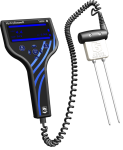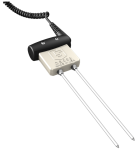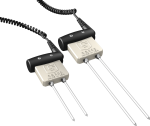
More accurate in soils with high bulk electrical conductivity






Overview
The CS650 is a multiparameter smart sensor that uses innovative techniques to monitor soil volumetric water content, bulk electrical conductivity, and temperature. It outputs an SDI-12 signal that many of our data loggers can measure.
Note: The cable termination options for this sensor are not suitable for use with an ET107 station. For this type of station, use the CS650-LC sensor instead, which has a suitable cable connector.
Read MoreBenefits and Features
- More accurate water content measurements in soils with bulk EC up to 3 dS m-1 without performing a soil-specific calibration
- Larger sample volume reduces error
- Measurement corrected for effects of soil texture and electrical conductivity
- Estimates soil-water content for a wide range of mineral soils
- Versatile sensor—measures dielectric permittivity, bulk electrical conductivity (EC), and soil temperature
Images




Similar Products
Detailed Description
The CS650 consists of two 30-cm-long stainless steel rods connected to a printed circuit board. The circuit board is encapsulated in epoxy and a shielded cable is attached to the circuit board for data logger connection.
The CS650 measures propagation time, signal attenuation, and temperature. Dielectric permittivity, volumetric water content, and bulk electrical conductivity are then derived from these raw values.
Measured signal attenuation is used to correct for the loss effect on reflection detection and thus propagation time measurement. This loss-effect correction allows accurate water content measurements in soils with bulk EC ≤3 dS m-1 without performing a soil specific calibration.
Soil bulk electrical conductivity is also calculated from the attenuation measurement. A thermistor in thermal contact with a probe rod near the epoxy surface measures temperature. Horizontal installation of the sensor provides accurate soil temperature measurement at the same depth as the water content. Temperature measurement in other orientations will be that of the region near the rod entrance into the epoxy body.
Compatibility
Note: The following shows notable compatibility information. It is not a comprehensive list of all compatible or incompatible products.
Data Loggers
| Product | Compatible | Note |
|---|---|---|
| CR1000 (retired) | ||
| CR1000X (retired) | ||
| CR300 (retired) | ||
| CR3000 (retired) | ||
| CR310 | ||
| CR350 | ||
| CR6 | ||
| CR800 (retired) | ||
| CR850 (retired) |
Additional Compatibility Information
RF Considerations
External RF Sources
External RF sources can affect the probe’s operation. Therefore, the probe should be located away from significant sources of RF such as ac power lines and motors.
Interprobe Interference
Multiple CS650 sensors can be installed within 4 inches of each other when using the standard data logger SDI-12 “M” command. The SDI-12 “M” command allows only one probe to be enabled at a time.
Installation Tool
The CS650G makes inserting soil-water sensors easier in dense or rocky soils. This tool can be hammered into the soil with force that might damage the sensor if the CS650G were not used. It makes pilot holes into which the rods of the sensors can then be inserted.
Specifications
| Measurements Made | Soil electrical conductivity (EC), relative dielectric permittivity, volumetric water content (VWC), soil temperature |
| Required Equipment | Measurement system |
| Soil Suitability | Long rods with large sensing volume (> 6 L) are suitable for soils with low to moderate electrical conductivity. |
| Rods | Not replaceable |
| Sensors | Not interchangeable |
| Sensing Volume | 7800 cm3 (~7.5 cm radius around each probe rod and 4.5 cm beyond the end of the rods) |
| Electromagnetic |
CE compliant Meets EN61326 requirements for protection against electrostatic discharge and surge. |
| Operating Temperature Range | -50° to +70°C |
| Sensor Output | SDI-12; serial RS-232 |
| Warm-up Time | 3 s |
| Measurement Time | 3 ms to measure; 600 ms to complete SDI-12 command |
| Power Supply Requirements | 6 to 18 Vdc (Must be able to supply 45 mA @ 12 Vdc.) |
| Maximum Cable Length | 610 m (2000 ft) combined length for up to 25 sensors connected to the same data logger control port |
| Rod Spacing | 32 mm (1.3 in.) |
| Ingress Protection Rating | IP68 |
| Rod Diameter | 3.2 mm (0.13 in.) |
| Rod Length | 300 mm (11.8 in.) |
| Probe Head Dimensions | 85 x 63 x 18 mm (3.3 x 2.5 x 0.7 in.) |
| Cable Weight | 35 g per m (0.38 oz per ft) |
| Probe Weight | 280 g (9.9 oz) without cable |
Current Drain |
|
| Active (3 ms) |
|
| Quiescent | 135 µA typical (@ 12 Vdc) |
Electrical Conductivity |
|
| Range for Solution EC | 0 to 3 dS/m |
| Range for Bulk EC | 0 to 3 dS/m |
| Accuracy | ±(5% of reading + 0.05 dS/m) |
| Precision | 0.5% of BEC |
Relative Dielectric Permittivity |
|
| Range | 1 to 81 |
| Accuracy |
|
| Precision | < 0.02 |
Volumetric Water Content |
|
| Range | 0 to 100% (with M4 command) |
| Water Content Accuracy |
|
| Precision | < 0.05% |
Soil Temperature |
|
| Range | -50° to +70°C |
| Resolution | 0.001°C |
| Accuracy |
|
| Precision | ±0.02°C |
Documents
Brochures
Manuals
Technical Papers
Downloads
CS650 / CS655 Firmware v.2 (429 KB) 12-02-2015
Current CS650 and CS655 firmware.
Note: The Device Configuration Utility and A200 Sensor-to-PC Interface are required to upload the included firmware to the sensor.
Frequently Asked Questions
Number of FAQs related to CS650: 54
Expand AllCollapse All
-
Campbell Scientific strongly discourages shortening the sensor’s rods. The electronics in the sensor head have been optimized to work with the 30 cm long rods. Shortening these rods will change the period average. Consequently, the equations in the firmware will become invalid and give inaccurate readings.
-
Because the reported volumetric water content reading is an average taken along the entire length of the rods, the sensor should be fully inserted into the soil. Otherwise, the reading will be the average of both the air and the soil, which will lead to an underestimation of water content. If the sensor rods are too long to go all the way into the soil, Campbell Scientific recommends inserting the rods at an angle until they are fully covered by soil.
-
The electrical conductivity (EC) of sea water is approximately 48 dS/m. The CS650 can measure permittivity in water with EC between 0 and 3 dS/m. EC readings become extremely unstable at conductivities higher than 3 dS/m and are reported as NAN or 9999999. Because EC is part of the permittivity equation, an EC reading of NAN leads to a permittivity reading of NAN as well. Thus, the CS650 cannot provide good readings in sea water.
With regard to sea ice, the electrical conductivity drops significantly when sea water freezes and the permittivity changes from approximately 88 down to approximately 4, as the water changes from a liquid to a solid state. With both EC and permittivity falling to levels that are within the CS650 measurement range, the sensor is expected to give valid readings in sea ice. The sensor is rugged and can withstand the cold temperatures. However, as the ice melts, there will be a point at which the electrical conductivity becomes too high to acquire a valid reading for either permittivity or electrical conductivity.
-
Probably not. The principle that makes these sensors work is that liquid water has a dielectric permittivity of close to 80, while soil solid particles have a dielectric permittivity of approximately 3 to 6. Because the permittivity of water is over an order of magnitude higher than that of soil solids, water content has a significant impact on the overall bulk dielectric permittivity of the soil. When the soil becomes very dry, that impact is minimized, and it becomes difficult for the sensor to detect small amounts of water. In air dry soil, there is residual water that does not respond to an electric field in the same way as it does when there is enough water to flow among soil pores. Residual water content can range from approximately 0.03 in coarse soils to approximately 0.25 in clay. In the natural environment, water contents below 0.05 indicate that the soil is as dry as it is likely to get. Very small changes in water content will likely cause a change in the sensor period average and permittivity readings, but, to interpret those changes, a very careful calibration using temperature compensation would need to be performed.
-
Modifications to the CS650 or CS655, including shortening the cable, will void the warranty. However, shortening the cable will not affect the sensor’s performance. If a decision is made to shorten the cable, care should be taken to avoid damaging the cable jacket and exposing bare wire except at the ends that connect to the data logger or multiplexer terminals.
-
Yes. Keeping the sensor rods parallel during installation is especially difficult in gravel, but it can be done. Gravel has large pore spaces that drain quickly, so the water content readings will likely show rapid changes between saturation and very dry. If small changes of water content at the dry end are of interest, a soil-specific calibration may need to be performed to convert period average directly to volumetric water content.
-
The CS650 and the CS655 are not ideal sensors for measuring water level. However, these sensors do respond to the abrupt change in permittivity at the air/water interface. A calibration could be performed to relate the period average or permittivity reading to the distance along the sensor rods where the air/water interface is located. From that, the water level can be determined. The permittivity of water is temperature dependent, so a temperature correction would be needed to acquire accurate results.
-
Yes. There is surge protection built into the sensor electronics. The sensor survives a surge of 2 kV at 42 ohm line-to-ground on digital I/O and 2 kV at 12 ohm line-to-ground on power. It also survives a surge of 2 kV at 2 ohm line-to-ground on the rods.
If additional surge protection is required, consider using the SVP100 Surge Voltage Protector DIN Rail with Mounting Hardware.
-
No. It is not possible to disable the logical tests in the firmware. If soil conditions cause frequent NAN values, it may be possible to perform a soil-specific calibration that will provide good results.
If permittivity is reported but the volumetric water content value is NAN, Campbell Scientific recommends a soil-specific calibration that converts permittivity to water content. This will take advantage of the bulk electrical conductivity correction that occurs in the firmware.
If both permittivity and volumetric water content have NAN values, it may be possible to perform a calibration that converts period average directly to volumetric water content.
For details on performing a soil-specific calibration, refer to “The Water Content Reflectometer Method for Measuring Volumetric Water Content” section in the CS650/CS655 manual. After a soil-specific equation is determined, it may be programmed into the data logger program or used in a spreadsheet to calculate the soil water content.
-
In soil that has a significant fraction of fines (loam, silt loam, silty clay loam, clay loam, clay), the CS655 is a suitable option because these soils tend to be more electrically conductive, and the CS655 operates over a larger range of electrical conductivity than the CS650. In applications where a smaller measurement volume is desired, such as larger greenhouse pots, the 12 cm long rods of the CS655 are preferable to the 30 cm long rods of the CS650.
Case Studies
Everglades National Park is the largest tropical wilderness in the United States and was created......read more
Agrivoltaics or dual-use solar is a system combining an agricultural crop (viticulture, arboriculture, field crops,......read more
Articles and Press Releases
Newsletter Articles
Privacy Policy Update
We've updated our privacy policy. Learn More
Cookie Consent
Update your cookie preferences. Update Cookie Preferences












